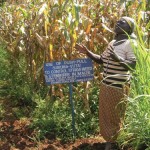
Termed “Push-Pull’, it relies on strategically deploying attractive and repellent plants in alternating rows to control the growth of African witchweed and stemborer insects. These are the biggest threat to cereal crops in Sub-Saharan Africa. Stem borers often destroy 80% of a crop.
Zeyaur Khan and his team at the International Centre of Insect Physiology and Ecology in Kenya, working with John Pickett at the Rothamsted Research in the United Kingdom, have come up with a way to use plants which release either repellents, used to “push” pests away or attractants used to “pull” pests into traps. These plants can also cause the witchweed to undergo suicidal germination so it cannot reproduce.
A border of attractive trap plant, such as Napier grass are planted around the crop. This grass releases attractants which lure and entrap stemborers and attracts predatory insects to attack them. Planted close to the cereal crops are repellent plants such as Desmodium which not only repels insects, it also causes suicidal germination in weeds, and it acts as a live mulch.
To date it has been adopted by over 30,000 smallholder farmers in East Africa, Their maize yields have increased from about one ton per hectare to three tons per hectare (1 t/ha to 3.5 t/ha).
It may be the economically feasible answer to pest control that African farmers are desperate for.
IUPAC Symposium 3B – Chemical Ecology and Crop Protection Thursday 11 am
IUPAC Symposium 4B – Natural Products, Tuesday 3.30 pm
Zeyaur Khan, International Centre of Insect Physiology and Ecology, Kenya; John Pickett, Rothamsted Research, United Kingdom
Abstract
Development and implementation of a push-pull strategy for management of cereal
Z. R. Khan, C. A.O. Midega
International Centre of Insect Physiology and Ecology, Nairobi, Kenya
J. A. Pickett, T. J.A. Bruce
Rothamsted Research, Harpenden, Herts, United Kingdom
We have developed a novel semiochemical-mediated crop protection strategy called â Push-Pullâ to control insect pests and parasitic weeds in subsistence African farming system. The presentation will highlight practical use of plants releasing semiochemicals to attract and/or ward off pest attack, to ensnare the attackers, to attract beneficial insects that will attack the pests, and, at the same time, to cause very effective suicidal germination and control of the African witchweed, Striga hermonthica, in cereals.
Typically, the plants are deployed in a push-pull arrangement with rows of an attractive plant at the border and a repellent plant as an inter-crop with cereals like maize. The intercrop (Desmodium uncinatum) was primarily selected because of novel allelopathic effects of flavonoid compounds in its root exudates on striga, some of which cause germination of striga seeds and others dramatically inhibit their subsequent development.
There are now more than 30,000 smallholder families using the push-pull approach in eastern Africa. The technology has improved their livelihood through increased agricultural productivity and improved environmental sustainability.